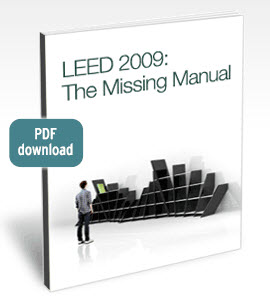 Keeping Up With LEED 2009 is a Challenge.
Keeping Up With LEED 2009 is a Challenge.
It’s difficult to keep up with all of the changes with LEED 2009. If you’re not routinely checking LEED addenda, interpretations, changes to ratings, etc. you’re missing out and LEED project management can become really cumbersome.
LEEDuser, one of the most popular LEED user groups around, has created a new all-in-one resource that puts all of the addenda, LEED Interpretations, review comments, frequently asked questions, core material in the LEED Reference Guide and countless other useful bits of information — all at your fingertips.
Introducing LEED 2009 NC: The Missing Manual.
LEED 2009: The Missing Manual is a Laser Guide to Hard-To-Find LEED Resources
There’s a wealth of resources at both LEEDuser’s and USGBC’s websites to help you prepare, organize, document and achieve every credit your project is aiming for. The LEED 2009 Missing Manual shows you how to find it and where to find it, with direct links to:
- Credit achievement rates
- Key interpretations
- Frequently asked questions for every LEED-NC 2009 credit
- Addenda
- Calculators
- LEED Checklists
- Key guidance documents and documentation submittal tips
We’ll also show you how to quickly find expert answers from among the tens of thousands of questions and comments available on LEEDuser’s credit forums — a vital resource for every LEED 2009 project.
Here is just a sample of the great informational material you’ll receive in this essential LEED 2009 manual:
SSc1: Site Selection
The project site is classified as “prime farmland,” but is in a developed area with buildings all around. Can I still comply with this credit? LEED does not have published exceptions to the prime farmland requirement. You would need to submit a CIR to get an official ruling. However, some projects have had success contacting the local USDA representative and requesting an evaluation to get an exemption due to the low probability that the land could be usable for agricultural purposes.
Our project site is in what FEMA refers to as “Zone D”—an area that has possible but undetermined flood hazards, as no analysis of flood hazards have been conducted. How can we tell if we comply with this credit? Seek the opinion of an equivalent local regulatory agency, or a professional hydrologist.
Is it possible to be exempted from the wetlands requirements under this credit if we protect or restore equivalent wetlands elsewhere? No, this is not an accepted compliance path. LEEDuser’s experts agree that you are unlikely to get traction with this due to the immediate and unsustainable impacts on local ecosystems and hydrology.
Is my site previously developed? Many projects have had questions about the definition of previously developed. Note that LEED 2009 projects have had the relevant definition updated by USGBC through a November 2011 addendum. Be sure to reference that definition.
Courtesy of LEED 2009: The Missing Manual
Free for LEEDuser members
Normally costing $79, LEED 2009: The Missing Manual is available free to all premium LEEDuser members.
If you’re not yet a LEEDuser member, you can become one at our regular $99.95 price and get LEED-NC 2009: The Missing Manual free at the same time. Your membership comes with a 100% money-back guarantee. Order today at LEEDUser.com.

